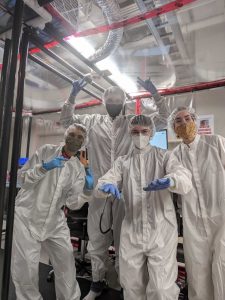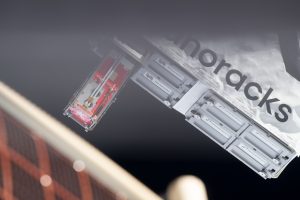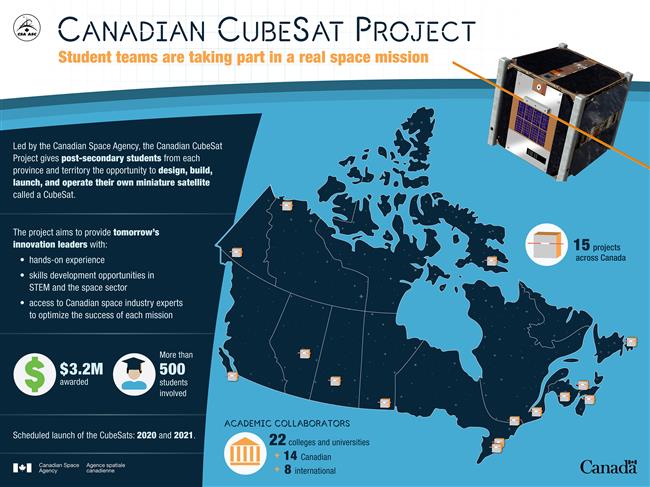Ex-Alta 2
The Experimental Albertan #2 Satellite
The Experimental Albertan #2 (Ex-Alta 2) was part of the Canadian CubeSat Project, an initiative from the Canadian Space Agency (CSA) designed to support student interest in space and provide valuable hands-on experience in the space industry.
Ex-Alta 2 was launched in March 2023 on a Falcon 9 rocket, as part of a resupply mission to the International Space Station (SpaceX CRS-27), and was deployed from the Nanoracks CubeSat Deployer in April 2023. Ex-Alta 2 orbited Earth until its natural de-orbit in November 2023.





Mission Objectives
- Predict, monitor, and assess wildfires and their after-effects using our open-source, student designed imager.
- Characterize direct current (DC) and alternating current (AC) magnetic fields at low earth orbit altitudes using a Digital Fluxgate Magnetometer (DFGM), designed by the University of Alberta’s Space Physics Lab.
- Support the training and development of highly qualified personnel by providing students with the opportunity to design, build and operate satellites. This includes the the development of open-source designs by students.
- Allow students to gain experience with amateur radio through satellite communications. Learn more about AlbertaSat’s amateur radio initiatives here.
Within the Canadian CubeSat Project, AlbertaSat partnered with Aurora Research Institute and Yukon University to form the Northern SPIRIT satellite consortium. The Northern SPIRIT consortium included one satellite from each organization: Ex-Alta 2, AuroraSat, and YukonSat.

Credit: Canadian Space Agency
How Ex-Alta 2 Used and Supported Amateur Radio
The Ex-Alta 2 satellite employed our very own AlbertaSat ground station to facilitate communication between the satellite and our computers. To make this a reality AlbertaSat created multiple antennae dedicated to S-Band frequencies and UHF frequencies as well working with the Northern Albertan Radio Club (NARC) members in conjunction with AlbertaSAT’s own certified radio amateur’s to make this happen!
Our UHF frequency attena, dubbed as Arke (see more information here), was create to enable full 360 degree signal coverage and ensure little to no loss on the signal strength around Ex-Alta 2. What this module performed was downlinking and up-linking of performance and status data to and from our ground station.
Our S-band frequency attenae named Hermes (more info here) is a one way attenae responsible for deleivering the payload data to the NARC’s ground station which then forwarded the data to the AlbertaSAT ground station.
How Ex-Alta 2 Studied Wildfires and Supported Open Source Development
Wildfires dramatically affect not only residents of Alberta, but many communities around the globe. At the time of writing, Canada-wide, an average of 2.1 million hectares of land are burned annually1 and the impact on the communities in rural areas at risk of wildfire damage is massive. Additionally, rising global temperatures mean that the number and intensity of wildfires is increasing every year.
With this in mind, AlbertaSat developed an in-house built multispectral imager dubbed Iris to be flown on-board Ex-Alta 2. Iris was designed to capture the forests in visible and invisible (infrared) light, providing scientists with the data to study wildfires and help protect us from their impact. Images taken of high risk zones will highlight vegetation growth which can provide clues as to when and where a wildfire will start. Many active wildfires produce huge amounts of aerosolized particles (smoke). Images of these smoke plumes can inform firefighters and scientists to where wildfires are occurring. Scorched and burnt earth as well as vegetation regrowth can be monitored over time using Iris. This is done to learn more about post fire recovery and the effects wildfires have on forest ecosystems. Ex-Alta 2 served as a proof of concept for a constellation of cubesats that can accurately predict and monitor wildfires with the information being relayed to emergency services in a timely manner.
The Impact of Ex-Alta 2, Post Launch
Ex-Alta 2 enabled many AlbertaSat members to kickstart their careers in the aerospace industry, equipped with hands-on experience on a collaborative space mission. Our alumni are now working at the Canadian Space Agency, MDA Space, Rocket Lab, SpaceX, Xiphos, and much more. We additionally have alumni completing graduate studies at the University of Alberta, University of Toronto (including UTIAS Space Flight Laboratory), University of Colorado Boulder, Royal College of Arts, and Delft University, among many others.
With their experience in developing Ex-Alta 2 and its Iris multispectral imager, some AlbertaSat alumni have gone on to found Wyvern, a satellite imaging company based out of Edmonton.
